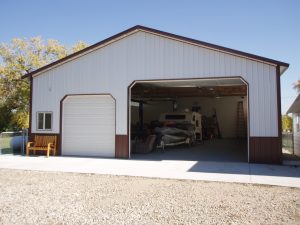Preaching Post Frame Conditioned Spaces – Insulation
We smile and greet each other inside the doorway, sharing pleasantries with friends old and new. Once assembled and comfortably seated upon hard wooden pews, we are relieved to be able to stand for a few minutes whilst singing a hymn or two and listening to announcements. Eventually it becomes pulpit time for me. As I prepare to bring forth fire and brimstone of how to effectively climate control your new (or existing) post frame building, my gaze finds most congregants are ….. fast asleep!
It must be so, for after services, I continue to get asked a variant of this same question I just preached about!
Reader RICK in BRIDGMAN writes:
 “I’m building a typical wood frame pole barn for a workshop. Plan is to have a heated 36×40 with a steel liner panel roof, and plywood or combination of plywood steel interior walls. I plan to blow about 10-12” of insulation in the attic area on top of the steel liner ceiling. I plan to put R19 fiberglass in the studded walls before installing the plywood interior wall. I really like the idea of a radiant barrier to help with the summer heat. I had thought about installing single bubble or another radiant type of foil to achieve that. I see that some radiant foils are moisture permeable, and others are not. What would be the best configuration to get a radiant barrier installed with the r-19 batts in the walls, and the blow insulation in the attic? Should the radiant barrier be placed on top of the wall girls and roof purlins prior to installing the roof and exterior wall metal panels, or should the radiant barrier be installed on the posts and trusses before the girls and purlins installed? Should the radiant barrier be installed inside the purlins and girts after the exterior siding and roof is installed? What type of fiberglass should be installed in the walls, craft faced or unfaced with a plastic vapor barrier to the heated side of the building?”
“I’m building a typical wood frame pole barn for a workshop. Plan is to have a heated 36×40 with a steel liner panel roof, and plywood or combination of plywood steel interior walls. I plan to blow about 10-12” of insulation in the attic area on top of the steel liner ceiling. I plan to put R19 fiberglass in the studded walls before installing the plywood interior wall. I really like the idea of a radiant barrier to help with the summer heat. I had thought about installing single bubble or another radiant type of foil to achieve that. I see that some radiant foils are moisture permeable, and others are not. What would be the best configuration to get a radiant barrier installed with the r-19 batts in the walls, and the blow insulation in the attic? Should the radiant barrier be placed on top of the wall girls and roof purlins prior to installing the roof and exterior wall metal panels, or should the radiant barrier be installed on the posts and trusses before the girls and purlins installed? Should the radiant barrier be installed inside the purlins and girts after the exterior siding and roof is installed? What type of fiberglass should be installed in the walls, craft faced or unfaced with a plastic vapor barrier to the heated side of the building?”
Mike the Pole Barn Guru writes:
So many questions and so many ways to do it wrong. Let’s try for right.
Exterior walls are not a place for a reflective radiant barrier, or for studs.
For your reading pleasure, I have written out my entire post frame building insulation sermon here: https://www.hansenpolebuildings.com/2018/06/pole-barn-insulation-oh-so-confusing/.
Rick’s building will be located in Michigan, where recommended attic insulation happens to be R49 to R60 (approximately 16 to 20 inches of blown in fiberglass). Energy Star attic insulation values for anywhere in America can be viewed: https://www.energystar.gov/index.cfm?c=home_sealing.hm_improvement_insulation_table
Hallelujah and Amen!






